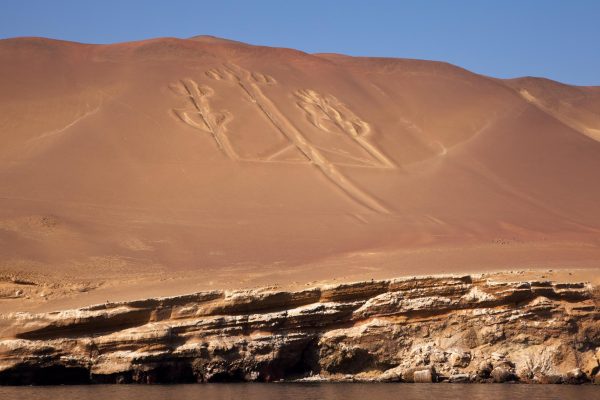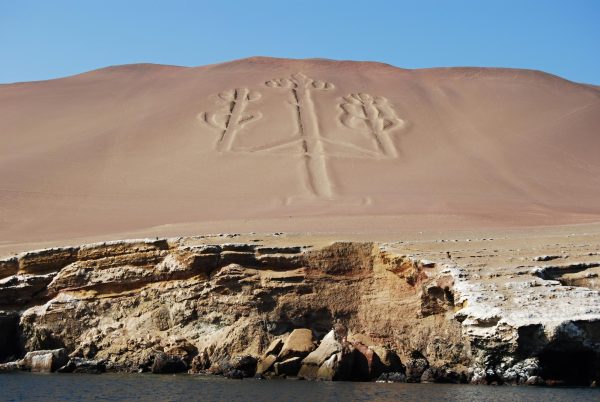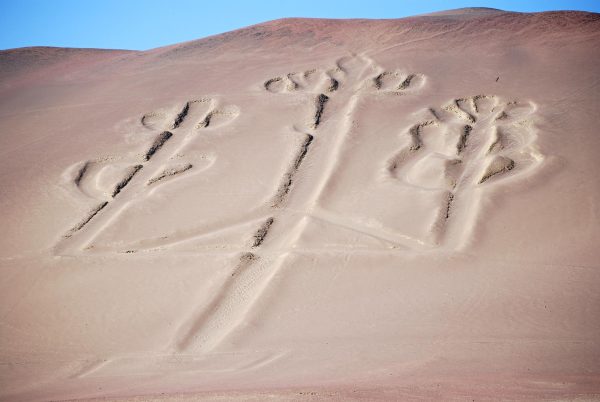Over one year ago, I investigated the Nazca lines, a series of unexplained illustrations in Peru’s Nazca Desert that have left theorists stumped for centuries. Well, 200 kilometers away and not too far from the mysterious drawings lies a cousin of the Nazca Lines. The Paracas Candelabra is only a singular sand carving, but the aura of mystery surrounding its creation reigns just as true. So what is the Paracas Candelabra, and does it compare to the legend of the notorious Nazca Lines?
 The technical term for depictions like the Paracas Candelabra is a “geoglyph”. This geoglyph is carved into the side of a hill near a body of water instead of being found in the heart of the desert like the Nazca Lines. The illustration could easily not be a candelabra, but its structure resembles such: whatever the drawing actually depicts is pretty much a mystery. It is about 600 feet long and can be spotted from 12 miles out to sea. It is found on the Paracas Peninsula within the Paracas National Reserve in Peru.
The technical term for depictions like the Paracas Candelabra is a “geoglyph”. This geoglyph is carved into the side of a hill near a body of water instead of being found in the heart of the desert like the Nazca Lines. The illustration could easily not be a candelabra, but its structure resembles such: whatever the drawing actually depicts is pretty much a mystery. It is about 600 feet long and can be spotted from 12 miles out to sea. It is found on the Paracas Peninsula within the Paracas National Reserve in Peru.
The drawing is not the only artifact that has been uncovered in the area. Pottery has been discovered, and through dating technology, scientists have been able to date them around 2000 years old. The Paracas culture, which is what the candelabra can call its namesake, has been associated with these pots. The Paracas people are known for their depictions of long heads. Despite this idea, some historians believe the geoglyph actually predates the Paracas and was created by an even older culture that previously lived in the area. Despite their similarities, the illustration is entirely separate from the Nazca people and their creations, since there is no historical or geographical evidence to suggest they were involved in this project.

The structure is etched about 2 feet deep into the sand and surrounded by a barrier of rocks and stones. This carving has also been documented historically, as in the late 1960s, when a French writer by the name of Robert Charroux made an expedition to the candelabra. He noted that there was little to no debris, like dust or sand, that could interfere with the perfect lines the candelabra sported. This, he indicated, means it could have been drawn at any point in history and avoided significant damage.
The possible origins of the candelabra have been hotly debated since its discovery. Author of “The Candelabra of the Andes” Frank Joseph posits it looks like a certain type of weed, while others believe it is a trident originating from a god named Viracocha. Its position is also brought into question. Since it was visible from the sea, its purpose was likely to indicate something to sailors or other passerby. Conquistadores who came across the candelabra thought it represented something religious despite no traces of indigenous religious tendencies toward Christianity. Some South American natives believe it could be used to measure earthquakes and other natural phenomena in the area or the Tree of Life.
Some theorists believe that, despite its location in South America, the candelabra has Hindu origins. In a sacred Hindu text called “Ramayana”, King Surgiva sends the Vanaras to four different corners of the world. He directs them to the Island of Java, New Zealand, and  an etched rock peak. The idea is that this references the candelabra. In fact, some Hindu words parallel the word “Paracas”, like “Prakash”, meaning light or brightness, and “Parakash” meaning distant view. This theory is a weak connection, but it is an explanation that has received some attention.
an etched rock peak. The idea is that this references the candelabra. In fact, some Hindu words parallel the word “Paracas”, like “Prakash”, meaning light or brightness, and “Parakash” meaning distant view. This theory is a weak connection, but it is an explanation that has received some attention.
Frank Joseph, a previously mentioned author and investigator, believed the weed it resembled was hallucinogenic, and the people who created the candelabra used it as an indication. They had to travel to California to obtain this weed and returned while searching for the candelabra as a landmark for home.
The true story of the Paracas Candelabra will likely remain forever a mystery unless the origins and intentions of the Paracas people (or whoever created the monument) are truly discovered. The candelabra will likely remain forever, unless human activity destroys it, due to its ideal location. Ultimately, it will be a mystery for a long time, but its beauty can still be admired for hundreds of years.
Resources:
https://www.hows.org.uk/personal/hillfigs/foreign/cand/candel.htm
https://www.theancientconnection.com/ancient-rock-art/the-paracas-candelabra/
https://www.amusingplanet.com/2017/07/paracas-candelabra-of-peru.html













































